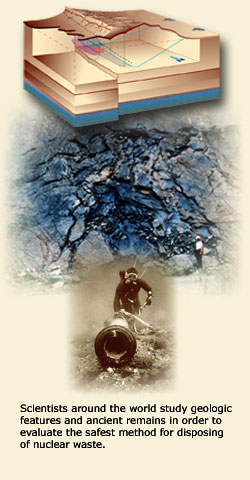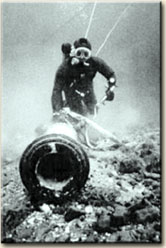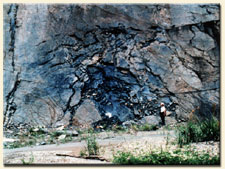Why Do Scientists Think a Repository Will Work?
Data from the past Studying the past to make models of the future — The Earth is old, about 4.6 billion years. Rocks above and below its surface can be dated to indicate when they were formed, whether tens of millions or hundreds of millions of years ago or even longer. Scientists study rocks to see how they were formed and to establish patterns in how erosion and other geologic processes have occurred. By examining the past geologic record and analyzing how rock formations have changed over many millennia, scientists can devise computer models to help them understand what might happen in the future. They develop these models based on observations and measurements about faults and earthquakes, continually refining them with new information. Data obtained from earthquakes, for instance, help scientists understand the depth of a fault, how big and in what direction one moves, and how one might move in the future. Comparable natural events — A natural nuclear reaction occurred two billion years ago, in Gabon, West Africa, when natural processes concentrated enough radioactive particles to cause an underground, nonexplosive nuclear chain reaction. This fission process, or splitting apart of atoms, occurred when uranium ore was transported by water into an underground area. Then, when conditions were just right, the atoms began to split and a chain reaction was underway. Since this event, long-lived waste from the nuclear reaction has moved, over time, less than three meters (10 feet) from the place where the reaction occurred. Scientists continue to examine the area to measure the movement of the radioactive material and understand how rock and soil acted to isolate the waste.1 Their findings are used as a natural analogue to support why they think an underground repository can safely isolate waste. An analogue is an alternative means of experimentation scientists use when they cannot duplicate an event in a laboratory because of limits on time and space.2
Because the bronze cannon sustained so little damage and has a copper content of 96% (bronze being an alloy of copper, tin and sometimes other elements), Swedish scientists have looked at copper as a container material for nuclear waste. They also are testing other materials such as ceramic and steel to develop a long-lasting nuclear waste container. Data from the present Finding a way to isolate nuclear waste safely has been the focus of much research for the past 40 years. For example, in the late 50s, as high-level nuclear waste accumulated from recycling or reprocessing nuclear materials, the National Academy of Sciences recommended disposing of the wastes deep underground in salt. As a result of this recommendation, in the early 1960s, salt formations in different geologic regions throughout the United States were studied for disposal sites. In later decades the federal government continued its research into geologic disposal by examining other rock types, such as granite and basalt, for disposal of nuclear waste. In the early 1980s, the Climax Spent Fuel Test was conducted on the Nevada Test Site to show that the technology already exists to transport, store and retrieve nuclear waste safely. Through the years scientists also have looked at a number of other options for disposing of nuclear waste. But these methods have not been pursued further because some were environmentally unsound, politically infeasible, or socially unacceptable. The following are among several explored. Burial in the ocean floor — This approach would place waste in durable canisters and then place the canisters in clay sediments on the ocean floor. Current international and legal factors about the deep ocean basins make this approach unacceptable. Sending waste into outer space — This approach entails shipping nuclear waste packages by space shuttle to be placed on the moon, or launching waste packages into the sun. Public safety and concern over shuttle launches, the number of launches that would be required, and the costs involved in shipping nullify this approach. Burial in polar ice caps — This approach would place waste within polar ice caps so that great masses of ice could enclose and isolate the radioactive material. Scientists decided not to pursue this approach further because of too many uncertainties and questions about the disposal process itself, extremely adverse weather conditions to contend with, and uncertainty about how to retrieve the waste from the thick masses of ice. A majority of countries using nuclear power as an energy source are pursuing the underground repository option to dispose of high-level nuclear waste. In our own country we have decades of research conducted on a variety of rock formations, and have conducted tests on the technology needed to operate a repository. Many scientists believe that a geologic repository is not only technically feasible, but that it is also an environmentally sound approach to disposing of high-level nuclear waste. References  Yucca Mountain Project |
||||||||||
 |
 |
 |


Yucca Mountain Project


